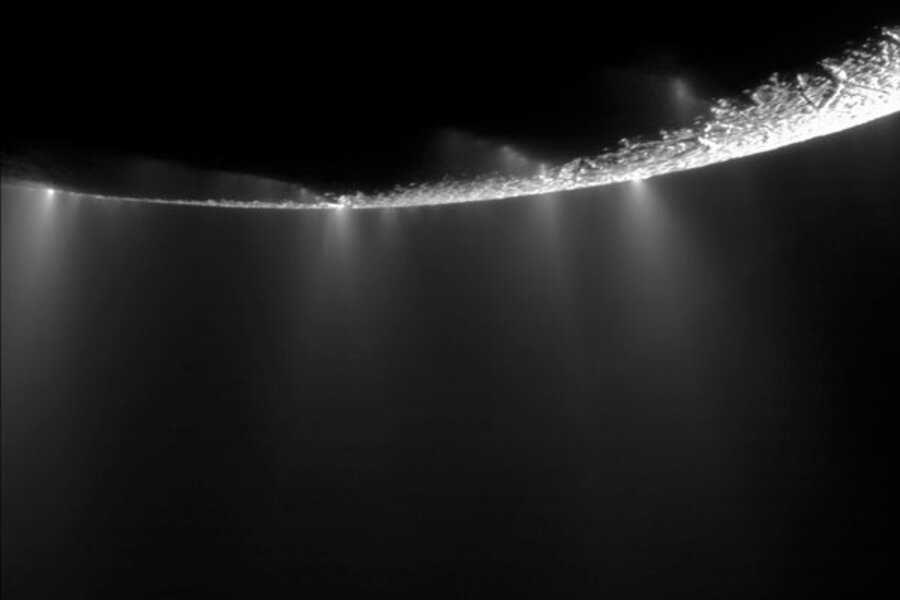Geysers on Saturn moon fueled by hidden sea and convulsing ice
Researchers have identified the icy equivalent of a mini Yellowstone on Saturn's moon Enceladus – 101 geysers spewing ice and water vapor, each erupting from its own tiny hot spot in the moon's south polar region.
The observations from instruments aboard NASA's Cassini spacecraft, currently touring Saturn and its moons, point to a plumbing system that reaches all the way down to a sea some 17 to 25 miles below the surface, the researchers say.
The work represents the most comprehensive look yet at unusual heat signatures in the south polar region, the geysers, and the forces that govern the pattern of their eruptions.
The analysis, which appears in two papers in the September issue of the Astronomical Journal and posted online Monday, looks to settle a debate over where the geysers originate, boosting Enceladus' already considerable scientific draw as a place to look for habitable environments.
Some 99 percent of the water-ice particles the geysers spew are rich in salts, suggesting that water came in contact with a rocky core. The salt content is similar to that of sea water. And the water vapor carries trace amounts of methane, ammonia, carbon dioxide, and light hydrocarbons.
During the past seven years, researchers have considered two sources for the geysers.
One idea posits that the sources are near the surface, where the ice is brittle. Gravitational interactions with another moon, Dione, force Enceladus to trace an elliptical orbit around Saturn. The changing stresses from Saturn's gravity during each orbit would prompt the sides of near-surface cracks on Enceladus to slide back and forth against each other, generating friction that would melt some of the ice. This would make liquid available for geysers.
The second possibility is that the liquid comes directly from the under-ice sea. The tidal forces from Saturn's gravity would serve as the invisible hand prying open, then closing the cracks that serve as conduits for the rising water and water vapor.
The new results favor this explanation. Enceladus' plumbing involves the pressure of an ice crust bearing down on the sea underneath, forcing water up through cracks in the ice, according to the picture assembled by one of the two teams
Once the ice rises high enough, the pressure subsides to be replaced by the release of carbon dioxide dissolved in the water. Once Saturn's gravity pries apart the cracks at the surface, the gas-laden water and water vapor are launched as a plume like spray from a shaken soda can. On the way out through the chilly surface, the latent heat in the water and water vapor – in essence the heat it took to convert ice to liquid and liquid to vapor in the first place – is released, generating the hot spots Cassini sees.
The results of the studies are a boon for future missions, which could sample the plumes for evidence of habitability, says Carolyn Porco, a planetary scientist at the Space Science Institute in Boulder, Colo., who heads Cassini's imaging team.
Plumes from geysers driven by near-surface melting could have salts or biological materials in them. But the salts and biological material likely would have arrived at the surface after millions of years of convection within the ice crust, explains Dr. Porco, who is the lead author on one of the two papers. The plume would contain ancient material.
Plume material coming directly from the under-ice sea takes only a few days to reach the surface, she says. "That's way better than investigating recently melted ice."
The team drew on data Cassini gathered over 6-1/2 years. Each Enceladus flyby came at a different approach angle and had a different angle of incoming sunlight. This allowed the team to map the location individual geysers by triangulation.
The geysers appeared along four large gashes in the south polar region's crust that the team dubbed tiger stripes when they were first discovered in 2005. Thermal images from Cassini indicate that one or two geysers are associated with each hot spot. The hots spots are about 30 feet across.
The researchers note that if the source of the geysers was frictional heating along near-surface cracks, the heat signatures would tend to cover a few kilometers of the surface. Instead, the hot spots are tiny and follow the tiger stripes.
Hot is a relative term. The team estimates that the hot spots are about 100 degrees below zero Fahrenheit. The rest of the surface is estimated for now at more than 350 degrees below zero. That may be generous. Porco notes that the measurements underpinning the estimate were taken during the south polar summer, when the region was in sunlight. A more accurate reading of the region's intrinsic temperature should come next year, when Cassini flies by Enceladus during the south polar winter.
In addition to the heating detected so far along the tiger stripes, she says, "We could have regional tidal heating, which could heat the whole area."








